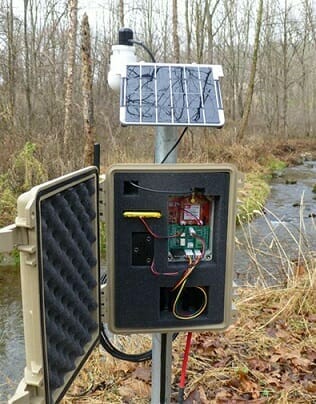
Scientists, anglers and interested public throughout the country rely on USGS gaging stations for real-time streamflow and water quality data. Often these stations are located near the mouth of larger rivers, so may not characterize what is happening in smaller coldwater trout streams. Now, rapidly emerging technologies in open-source electronics are allowing volunteer groups to collect valuable real-time water data. Developed by Stroud Water Research Center, the EnviroDIY Monitoring Station is a low-cost, easy-to-use water monitoring station designed to collect continuous data, often taking measurements every five minutes. Data are then uploaded to an online database via cellular signal for real-time access to current stream conditions.

The EnviroDIY Monitoring Stations are solar powered and can be connected to a variety of environmental sensors. The electronic “brain” of the sensor station is the Mayfly data logger, a microcontroller board designed by Stroud. TU has deployed stations measuring temperature, depth, conductivity and turbidity. Data are sent from the station to an online database via 4G cellular signal, though there are other data communication methods that can be explored in areas without 4G availability.
This effort is part of EnviroDIY, a community of do-it-yourself environmental monitoring. Founded by Stroud, the community collaborates on the development of open-source hardware and software solutions for observing the environment, with a focus on water monitoring. The group is working to support an explosion of real-time monitoring by creating monitoring resources that are low-cost, easy to learn and easy to use.
TU is now building the necessary capacity to be a key service provider, bringing this technological capacity to our chapters and partners throughout the country. This includes building the stations in-house and providing training and technical support to volunteer groups adopting the technology. Once volunteers have received training on the requirements for station installation and ongoing maintenance, the EnviroDIY Sensor Stations have the potential to dramatically expand the availability of quality real-time water data, and TU is poised play a key role in identifying areas where there is a need for this type of data and supporting groups to adopt and deploy stations. To learn more, including measurement parameters, installation instructions, station maintenance, troubleshooting, and more, please check out the TU EnviroDIY Monitoring Station Manual. Contact Jake Lemon, TU’s Monitoring and Community Science Manager, at jlemon@tu.org with questions regarding this program. Additionally, you may contact Matt Barney, TU Senior Programmer at mbarney@tu.org.


